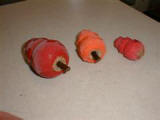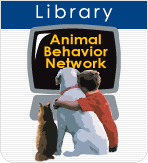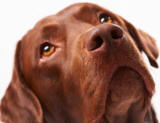|
Need Help?
|
|
Call
1-800-372-3706
to
speak to a Veterinary Behavior Technician |
|
Paws To Speak!
Member
Main Menu
|

Destructive
Digging
Pet Professional Tip
Use
non-destructible chews such as Kongs stuffed with
canned food, then frozen.

|
 |
|
Help is at your
fingertips by library, email and
phone. |

Click on
Library Icon
to learn more
|
Introduction
Destructive play occurs when the
dog is enjoying him or herself
while destroying something that
is not approved for destruction.
This typically starts either as
a result of boredom with a
squeaky toy or plush toy that
the dog disassembles and tears
apart. Some dogs seem to enjoy
the process of destroying things
more than others. With a newly
adopted puppy or dog, the
strategy is to supervise the dog
initially, and intervene at the
first sign of this destructive
behavior.
|
If the dog begins to destroy
an object not meant for
destruction, substitute
something acceptable like a
chew toy that the dog can
work on but not immediately
destroy. |
Distracting the
dog from destruction
.jpg) Experiment
to discover what your dog likes
to chew. (e.g., a Kong® toy,
Planet Pet Product, Nylabone®,
rawhide chew). When taking away
an dog toy that the dog is
starting to destroy, it is best
to "trade up." In other
words, find something the dog
wants more than the toy this is
being destroyed. For example, if
the dog starts to fray a soft
fabric toy, tell the dog, "off".
If the dog releases the toy,
immediately give the dog the
"trade up" such as a Kong® with
peanut butter inside it. Dogs
are often more willing to
release a toy if you ask them to
"sit" first. The new chew toy is
a reward for sitting and
releasing the object of
destruction. Experiment
to discover what your dog likes
to chew. (e.g., a Kong® toy,
Planet Pet Product, Nylabone®,
rawhide chew). When taking away
an dog toy that the dog is
starting to destroy, it is best
to "trade up." In other
words, find something the dog
wants more than the toy this is
being destroyed. For example, if
the dog starts to fray a soft
fabric toy, tell the dog, "off".
If the dog releases the toy,
immediately give the dog the
"trade up" such as a Kong® with
peanut butter inside it. Dogs
are often more willing to
release a toy if you ask them to
"sit" first. The new chew toy is
a reward for sitting and
releasing the object of
destruction.
Supervise
sessions with toys that the dog
likes to destroy (but are not
approved for destruction). For
example, follow a 5-minute
obedience session with brief
play time with the coveted toy
as the reward. Be interactive
with the dog and the toy. If the
dog still starts destroying the
toy, follow the guidelines
outlined in the above paragraph.
|
If the dog begins to destroy
an object not meant for
destruction, substitute
something acceptable like a
chew toy that the dog can
work on but not immediately
destroy. |
|
Because each pet has an
individual personality, you
might find that your dog REALLY
likes to take things apart. If
this is part of his or her basic
personality, shop for some toys
that cannot be destroyed and
others that if destroyed slowly
will not pose a hazard.
(Great care must be given to the
choice of edible toys to avoid
the danger of intestinal
blockages). Rawhides and other
hard chews that are edible, need
to be introduced slowly and
carefully. It is important to
allow the dog to initially chew
on a rawhide for a supervised
period of time and then to
remove it. Consider putting
rawhides in a baggy in the
freezer between chew times. Dogs
can work on and gradually break
off a piece of the chew toy and
then swallow it without any
harm. By working at it, he or
she can take the edges off and
can eventually devour the entire
thing.
When first presenting chew toys,
only allow a limited time of
chewing to prevent the dog from
eating so much he or she gets
sick or develops an intestinal
obstruction.
|